Smart Poles Market Research, 2031
The Global Smart Poles Market was valued at $7.1 billion in 2021, and is projected to reach $35.9 billion by 2031, growing at a CAGR of 17.9% from 2022 to 2031.
Smart poles are becoming more popular due to their multi-functionality. Smart poles are an essential component of the smart city infrastructure, which aims to make cities more efficient, sustainable, and safer. They are designed to support the development of smart cities by providing a network of infrastructure that can support the integration of advanced technologies such as 5G, IoT, and AI.
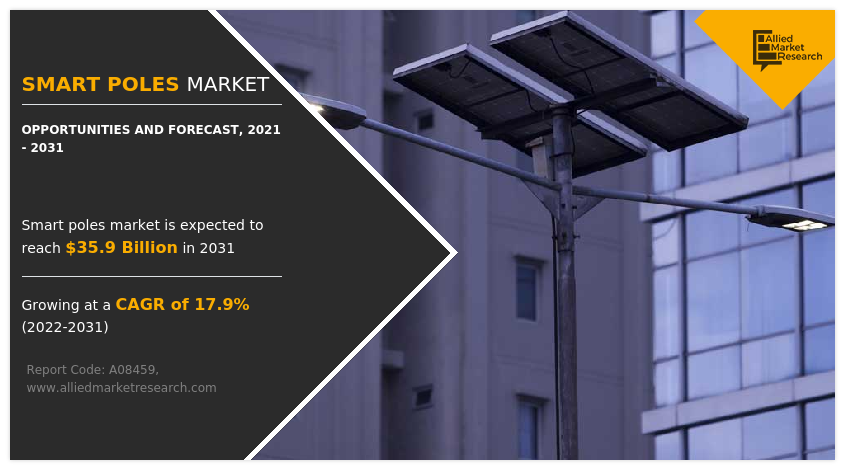
There is a rise in the need for a well-established, resilient infrastructure for proper traffic management, as well as an increase in the use of connected devices and cutting-edge technologies. Smart poles, also known as intelligent light poles, can provide primary illumination as well as sophisticated features such as intelligent lights, communication devices, cameras, weather monitoring systems, announcement speakers, signs, and an optional EV charger. Smart poles are commonly used in essential sites such as public spaces, roadways, highways, harbors, and railways, as well as by many state governments to provide Wi-Fi connectivity to their citizens.
However, countries with limited resources are unable to employ smart pole solutions due to the high cost of establishing the 5G smart pole, Internet of Things (IoT), and artificial intelligence (AI) systems. This factor is expected to hamper the smart poles market growth. The cost of transforming existing infrastructure serves as a constraint for governments to retain large-scale investments. Though smarter infrastructure reduces operating costs and increases energy efficiency, upfront costs are a significant obstacle to the market growth.
Smart light pole can be an integral part of smart city infrastructure. With the increase in smart city initiatives across the globe, the demand for smart poles is likely to increase. With the rise in the need for efficient and sustainable urban infrastructure, governments and municipal corporations are investing in smart city projects. All these factors are projected to lead to an increase in demand for smart poles in the upcoming years. The increase in smart city initiatives and the adoption of smart poles is anticipated to create significant opportunities for the smart poles market players.
The key players profiled in this smart poles industry report include Philips Lighting Holding B.V., GE Lighting Co. Ltd, Hubbell Incorporated, Cree, Inc., Eaton Corporation, Acuity Brands, Sunna Design, Mobile Pro Systems, Goldspar Australia Pty Ltd., and Virtual Extension Ltd.
The smart poles market analysis report is segmented on the basis of type of hardware, products, installation, application, and region. By type of hardware, it is classified into lighting lamp, pole bracket and pole body, communication device, controller, and others. By products, it is classified into hardware, software, and services. By installation, it is classified into new installation and retrofit. By application, it is classified into highways and roadways, public places, and railways and harbors. By region, the market is analyzed across North America, Europe, Asia-Pacific, and LAMEA.
Segment Overview
The smart poles market is segmented into Type of Hardware, Installation, Products and Application.
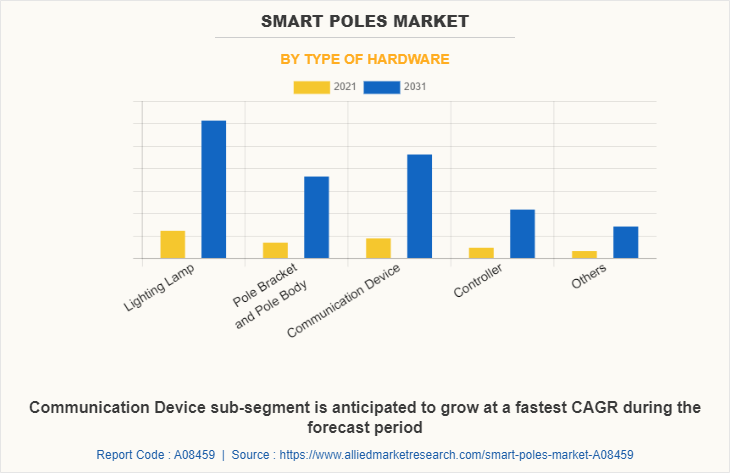
By type of hardware, the lighting lamp sub-segment dominated the market in 2021. The lighting lamp market is highly fragmented, with numerous producers launching lamps of various sizes. The lighting in smart poles is an important feature that provides illumination for pedestrians and drivers, enhances public safety, and reduces energy consumption through intelligent control systems. The driver of the lighting lamp segment in smart poles is an electronic circuit that regulates the power supply to the lighting system, which is essential for their optimal performance and longevity. These are predicted to be the major factors affecting the smart poles market size during the forecast period.
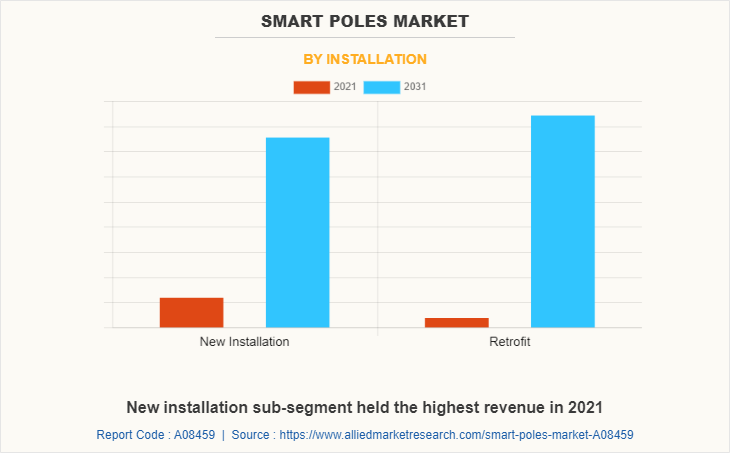
By installation, the retrofit sub-segment dominated the global smart poles market share in 2021. Retrofit smart poles perform an essential role in addressing the problem of urban air pollution since they can monitor a variety of environmental parameters, such as particulate matter concentrations, temperature, and humidity, to provide a comprehensive picture of an area's overall air quality. Such applications of retrofit smart poles are estimated to drive the growth for the sub-segment during the forecast period.
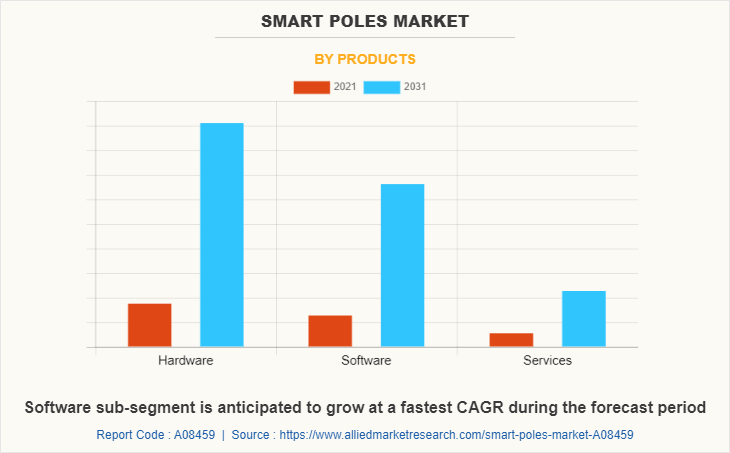
By products, the hardware sub-segment dominated the global smart poles market share in 2021. The hardware segment of the smart poles market includes the physical components and devices that allow the poles to function as intelligent and connected devices. Many smart poles installed across the world are equipped with cameras and air quality sensors to monitor growing pollution levels. Several mobile technology companies are collaborating with alternative energy system suppliers to develop and market efficient poles that support video analytics, intelligent lighting, and Wi-Fi access points. Such collaborations help to create opportunities for camera and air quality sensor manufacturers to produce unique solutions for smart poles. These factors are expected to increase the demand for the hardware segment in the upcoming years.
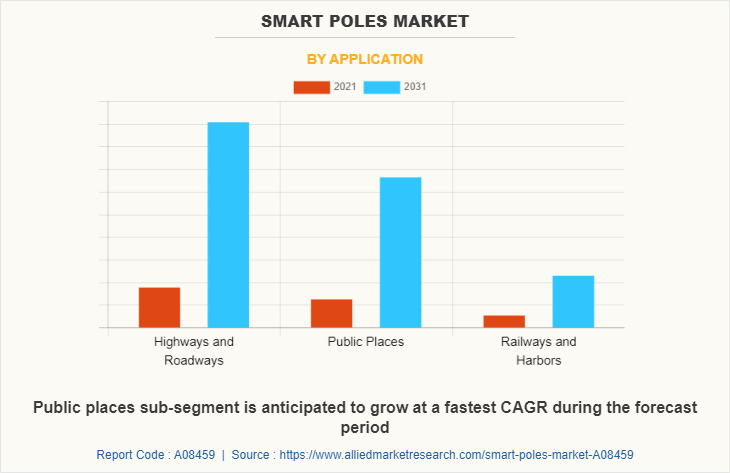
By application, the new installation sub-segment dominated the global smart poles market share in 2021. There is a rise in government activities towards the construction of smart poles in industrialized nations such as the U.S., the UK, France, and Germany. Furthermore, industry participants such as ELKO EP, E.ON SE, and Signify Holdings are focusing on the development of smart poles equipped with security cameras, air quality sensors, and optional electric car chargers.
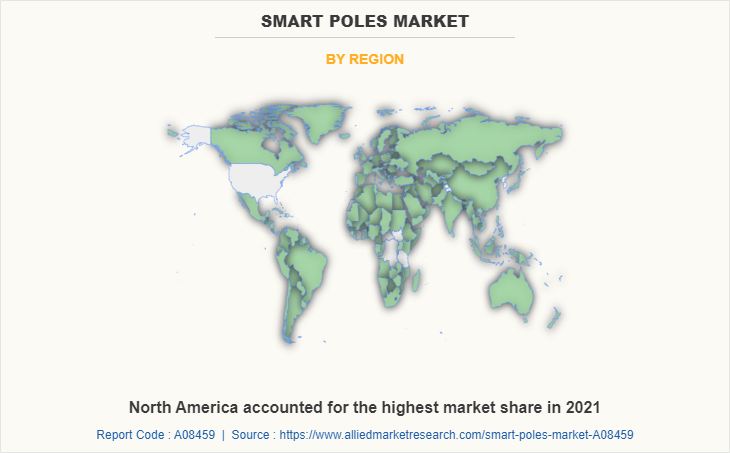
By region, North America dominated the global market in 2021. The smart poles demand in countries, namely the U.S. and Canada, are growing rapidly as they can cut down on energy expenditures. The system appears to be primarily driven by the falling cost of LED lights and the excellent return on investment (ROI) from smart lighting. The development of smart poles system is also being aided by numerous amenities including Wi-Fi connectivity, electric vehicle charging stations, and pollution monitors. The demand is rising owing to some of its features such as real-time monitoring and daylight-saving time. The increase in implementation of connected streetlights in the region is expected to boost the market growth. Several areas in the U.S. have taken steps to install AI-powered smart poles to help citizens and business owners in emergency circumstances.
Impact of COVID-19 on the Global Smart Poles Industry
- Nearly the entire world has been impacted by COVID-19, which has severely disrupted economic and healthcare systems. Governments were forced to take measures such as lockdowns, travel restrictions, and social distancing due to the pandemic. These steps were taken by governments around the world to control the spread of the virus and reduce the number of fatalities.
- The outbreak of the COVID-19 pandemic has caused a global economic slowdown. The operations of various construction and development projects were also affected, putting the growth of the smart pole market at risk. To halt the spread of the virus, the governments of the U.S. and China, for example, had to put a halt to construction and infrastructure activities during the pandemic. However, as limitations are eased throughout the globe, the market is expected to grow significantly during the forecast period.
- For example, the crisis that brought Silicon Valley dangerously close to total closure made it difficult to fulfill the requirements of the development of smart cities and hindered strategic management and planning by the government and other stakeholders.
- The establishment of new smart pole projects has been hampered by the global economic slump since the healthcare industry received the majority of government funding as a result of the COVID-19 virus's quick spread, which has had a significant negative impact on the market.
Key Benefits For Stakeholders
- This report provides a quantitative analysis of the market segments, current trends, estimations, and dynamics of the smart poles market overview from 2021 to 2031 to identify the prevailing smart poles market opportunities.
- The market research is offered along with information related to key drivers, restraints, and opportunities.
- Porter's five forces analysis highlights the potency of buyers and suppliers to enable stakeholders make profit-oriented business decisions and strengthen their supplier-buyer network.
- In-depth analysis of the smart poles market segmentation assists to determine the prevailing market opportunities.
- Major countries in each region are mapped according to their revenue contribution to the global market.
- Market player positioning facilitates benchmarking and provides a clear understanding of the present position of the market players.
- The report includes the analysis of the regional as well as global smart poles market trends, key players, market segments, application areas, and market growth strategies.
Smart Poles Market Report Highlights
| Aspects | Details |
| Market Size By 2031 | USD 35.9 billion |
| Growth Rate | CAGR of 17.9% |
| Forecast period | 2021 - 2031 |
| Report Pages | 280 |
| By Type of Hardware |
|
| By Installation |
|
| By Products |
|
| By Application |
|
| By Region |
|
| Key Market Players | Sunna Design, Philips Lighting Holding B.V., Virtual Extension Ltd., Eaton Corporation, Hubbell Incorporated, Cree, Inc., Goldspar Australia Pty Ltd., Acuity Brands, Inc., GE Lighting Co. Ltd, Mobile Pro Systems |
Analyst Review
The incorporation of Internet of Things (IoT) technology has enabled smart poles to perform multiple functions such as traffic management, public safety and security, and environmental monitoring. An increase in demand for 5G technology is the key factor that is projected to drive the growth of the global smart poles market during the forecast period. The integration of 5G technology into smart poles has also increased the demand for smart poles, as cities look for ways to improve their wireless network coverage and capacity. The use of smart poles as charging stations for electric vehicles has also emerged as a significant application in recent years, driving the growth of the smart poles market. However, the high cost of technical integration is one of the impediments to the market expansion. Smart pole installation is substantially more costly than traditional street lighting installation. Therefore, underdeveloped countries continue to fall behind in adopting modern technology such as smart poles. In addition, the integration of smart poles with emergency response systems, such as fire alarms, helps to reduce response time in case of an emergency. The poles can also be equipped with real-time crime monitoring systems, which provide authorities with immediate information about potential security threats and enable them to take action promptly. These factors are anticipated to create significant growth opportunities for the key players operating in the smart pole market during the forecast period.
Among the analyzed regions, LAMEA accounted for the highest revenue in the market in 2021, followed by North America, Europe, and Asia-Pacific. Rapid industrialization and urbanization are the key factors responsible for the leading position of LAMEA and North America in the global smart poles market.
The expanding infrastructure for smart city projects, combined with the integration of Internet of Things (IoT) and Artificial Intelligence technologies is driving the smart poles market which is anticipated to generate excellent opportunities for the key market players
The major growth strategies adopted by smart poles market players are investment and agreement.
North America will provide more business opportunities for the global smart poles market in the future.
Philips Lighting Holding B.V., GE Lighting Co. Ltd, Hubbell Incorporated, Cree, Inc., Eaton Corporation, Acuity Brands, Sunna Design, Mobile Pro Systems, Goldspar Australia Pty Ltd., and Virtual Extension Ltd. are the major players in the smart poles market.
The highways and roadways sub-segment of the application acquired the maximum share of the global smart poles market in 2021.
Roadway ministries and the construction industry are the major customers in the global smart poles market.
The report provides an extensive qualitative and quantitative analysis of the current trends and future estimations of the global smart poles market from 2022 to 2031 to determine the prevailing opportunities.
Smart poles are gaining popularity in cities to minimize traffic congestion and prevent accidents, as they provide traffic management with the following attributes: traffic monitoring, traffic guidance, car monitoring, and parking guidance. This is the major factor expected to drive the adoption of smart poles.
Loading Table Of Content...



